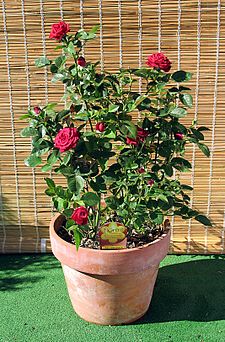ORNAMENTAL GARDENING
Ornamental gardening can be simply defined as planting various plants on a piece of ground from and for an artistic point of view. This entails designing such a garden to follow given patterns for a general pleasurable look. An ornamental garden therefore is one that is planted purely for aesthetic value.
History is decked with many famous types of ornamental gardens. A few of these are the Versailles of France, Keukenhof Gardens Netherlands or Ryoanji Zen garden in Kyoto Japan.
Ornamental gardening can be simply defined as planting various plants on a piece of ground from and for an artistic point of view. This entails designing such a garden to follow given patterns for a general pleasurable look. An ornamental garden therefore is one that is planted purely for aesthetic value.
History is decked with many famous types of ornamental gardens. A few of these are the Versailles of France, Keukenhof Gardens Netherlands or Ryoanji Zen garden in Kyoto Japan.
Uses of ornamental gardens
These gardens make surrounding buildings more visually interesting. For institutions devote to contemplation, especially religious institutions, ornamental gardens provide locations with ambient environment for meditation.
Ornamental gardens are also used for pleasure and recreation. The ancient ‘Hanging Gardens of Babylon‘ were made for pleasure – a gift to the Babylonian king’s love. They are also established not only for thepleasurable aspects but also for botanical studiessuch as the Keukenhof in Netherlands.
Benefits of ornamental gardens.
Ornamental gardens are pleasant to be in and are used for activities such as sports, concerts and weddings. Pleasantly manicured lawns, hedges and a myriad of flowers and plant make these gardens attractive. For others, they are the perfect grounds for meditation purposes.
They help regulate the micro-climate around them: Plants’ ability to enrich air of oxygen and rid it of toxins is immeasurable. They also add onto the atmospheric humidity levels for a cooler and cleaner location to be in.
The gardens are also a habitat for birds, insects and other creatures. What more diversity would you wish for than a complete and rewarding ecosystem such as these?
They help regulate the micro-climate around them: Plants’ ability to enrich air of oxygen and rid it of toxins is immeasurable. They also add onto the atmospheric humidity levels for a cooler and cleaner location to be in.
The gardens are also a habitat for birds, insects and other creatures. What more diversity would you wish for than a complete and rewarding ecosystem such as these?
Layout of ornamental gardens
The layout an ornamental garden takes is dependent on the following factors:
- Climate.
- Plants involved.
- Surrounding architecture and their uses.
- Intended use of the garden such as in the case of meditation Zen gardens.
There are many types of ornamental gardens that one can make for various uses be it at home or for commercial use. Whichever way you go, remember that nature is the best gift that you can grant your heart, mind and body, especially in this age of concrete jungles.
WHOLE TREES
LANDSCAPE AND ORNAMENTAL TREES
Landscape and ornamental trees are an important part of human life. They provide shade and beauty around homes, schools, markets and shopping areas, places of work, along streets and highways, in city parks and other areas. They also help conserve energy and the quality of air, water and soil.
Virtually all species of temperate broad-leaved trees are important landscape and ornamental plants and fulfil one or more functions in landscape design. As good as all countries have some level of nursery industry that offers for sale planting stock for landscape and ornamental purposes. Small-scale nursery operations are often an excellent opportunity for small business or family-run enterprises.
HISTORICAL ASPECTS
Trees have been used as ornamental plants since the earliest of times. More than 4 000 years ago, the Egyptians wrote about trees being transplanted with a ball of soil around their roots. Some trees were moved up to 2 400 km by boat. In Greece, Theophrastus (370-285 BC) and Pliny (AD 23-79) gave instructions for tree planting and care. Many books on the care of trees and woody shrubs have been written since those early times.
During the Middle Ages, botanical gardens contained primarily plants of medicinal importance. Later, the gardens of private estates contained many exotic plants introduced via trade and travel. Many of these gardens are now public and are great sources of information and recreation.
By the early 1700s, trees were being planted with some frequency in the cities and estates of Europe. During the early settlement of North America, trees were cut to make room for farms and communities. During the late 1700s, however, trees were being planted in town squares. Unfortunately, after the trees were planted, few received care, except perhaps on large estates. As settlers migrated west into the open prairies, they planted seeds of fruit trees and other trees to shelter their homes from high winds.
In the early 1900s, national research institutes in Europe and North America began to study fruit and forest trees and by the 1950s, these institutes began working on problems associated with landscape and ornamental trees. The need for this research was accelerated with the introduction of several major pests and diseases that caused serious problems with both forest and ornamental trees (e.g. Dutch elm disease (Ophiostoma ulmi) and white pine blister rust (Cronartium ribicola).Experiment stations, botanical gardens, arboretums and some large plant nurseries have long been involved in the introduction and evaluation of landscape materials that are able to tolerate the rigours of the urban environment. These events led to the development of the science of arboriculture - the planting and care of trees and other woody plants [Harris, 1976].
BENEFITS
Ornamental trees provide a basic contact with nature and heighten pleasure in human surroundings. Their value is difficult to quantify in economic terms but some of the aesthetic benefits they can provide are:
1. A variety of colour, form, texture and pattern;
2. Softening of harsh architectural lines;
3. Formation of vistas, frame views, provision of focal points and definition of spaces;
4. Trees can make enticing play areas;
5. Cooling shade, pleasant fragrances, intriguing sounds and serene settings;
6. They can create the impression of a well-established place in new residential areas and reduce the raw “unfinished” look.
Ornamental trees can add to the value of real estates, although there are few examples of accurate assessments. One study in the eastern United States indicated that trees increased the appraised value of undeveloped land by 27 percent and that of 0.2 ha residential lots with houses by 7 percent. Industry officials have found that attractive buildings and landscapes result in above-average labour productivity, lower absenteeism and easier recruitment of workers with hard-to-find skills [Harris, 1976].
Trees can have considerable effects on the microclimate of areas of heavy human population. They absorb heat as they transpire, provide shade that reduces solar radiation and reflection can reduce or increase wind speed, and can increase fog precipitation and snow deposition [Harris, 1976]. Trees can have a significant beneficial effect on the cost of winter heating and summer cooling of buildings. They break up urban “heat islands” by providing shade. It has been estimated that the shade provided by strategically placed trees near a residential home can reduce air conditioning costs by 30-50 percent, and trees planted as windbreaks around buildings can reduce winter heating energy use by 4-22 percent [Ciesla, 1995; Sampson, 1992].
DESIRABLE CHARACTERISTICS
Most temperate broad-leaved trees are used as ornamental and landscape plants in some form. Desirable characteristics of the trees selected for this purpose include genetic variability, foliage colour and density, overall form, growth rate (both fast and slow growing plants may be desired) and ability to grow and survive under a wide range of climatic and soil conditions.
Genetic variability
Genetic variability within species is a desirable trait to have in trees and plants used as ornamentals. Many trees have one or more distinct varieties. Varieties are considered to be one step below the species level in the taxonomic hierarchy. For example Salix alba var. vitellina is a variety of S. alba found in Switzerland that has especially good form and brilliant yellow shoots that are very decorative [FAO, 1979]. They are characterized by having distinct characteristics of foliage or form but are inseparable at the species level. Varieties appear in nature, are genetically stable and reproduce from seed. Cultivars are mutations or distinct forms of plants, initially found in nature, and propagated asexually by cutting or grafting with the objective of maintaining those characteristics for a saleable plant. Cultivars are not part of the classic Linnean taxonomic hierarchy. Cultivar names have been developed by the nursery industry to reflect the characteristics of the plant, the location where it was discovered, its discoverer, etc., but are not always latinized [Harrison, 1975]. For example, a purple leafed form of Fagus sylvatica, first cultivated in Germany during the eighteenth century, is designated as F. sylvatica Purpurea [Edlin, 1985]. Another well-known cultivar of this tree is F. sylvatica Pendula, a weeping form with long branches [Samson and Samson, 1986]. Certain cultivars of Salix alba grown commercially in the Netherlands are designated Liempe, Belders and Lievelde. These cultivars are produced vegetatively and are male trees that have good form and are fast growing [FAO, 1979]. Cultivariants are cultivars that appear somewhat different from their vegetative parents due to propagation from non-typical foliage [Harrison, 1975].
Foliage colour
Another desired characteristic of deciduous temperate broad-leaved trees used as landscape or ornamentals is the foliage colour. Several trees such as various cultivars of Fagus sylvatica and Acer palmatum have deep reddish-purple foliage colour throughout the growing season. Their colours can add interest and variety to a landscape during the entire growing season [Dirr, 1990].
Brilliant foliage colour during the autumn season is another desirable characteristic of landscape and ornamental trees. Many deciduous broad-leaved trees produce brilliant displays of fall colour. For example, the foliage of several oaks, e.g. northern red oak (Quercus rubrum), scarlet oak (Q. coccinea) and pin oak (Q. palustris), turn a brilliant scarlet colour in autumn. Other trees with bright autumn foliage colour include Acer saccharum (red-orange), A. rubrum (bright red), Betula spp. (yellow), Fraxinus pennsylvanica (bright yellow or violet depending on cultivars), Cornus florida (deep red), Liquidambar styraciflua (deep red), Pistacia chinensis (bright red) and Liriodendron tulipifera (bright yellow) [Ferguson, 1982].
Growth
Rapid growth is a desired characteristic of trees established in new developments so that the harshness of new construction is minimized in as short a time as possible. Silver maple (Acer saccharinum) is a popular fast growing shade tree but is susceptible to iron chlorosis when planted on alkaline or iron poor soils [Dirr, 1980]. Other fast-growing trees used in new landscapes include Alnus spp., Catalpa spp., Paulownia tomentosa, Populus spp., Robinia pseudoacacia, Salix spp., Sapium sebiferum and Ulmus spp. [Ferguson, 1982].
In other situations, trees with relatively slow rates of growth may be required. Examples include small gardens or patios where a fast-growing tree would quickly outgrow available space. Examples of slow-growing trees which would work well in limited space include Acer palmatum, Cercis canadensis, Cornus spp., certain cultivars of Prunus, Pistacia chinensis and Ostrya virginiana [Ferguson, 1982].
Colourful flowers and fruits
Flowering trees are especially popular in early spring when some species produce abundant flowers before leafing out. Two outstanding examples are the Japanese flowering cherries (Prunus serullata and P. yedoensis). Cultivars of these trees were given by the Japanese Government to the United States Government and were planted among several famous monuments in Washington, DC, where the annual cherry blossom display is world famous. Other trees that produce abundant and colourful spring flowers are Amalachier canadensis, Crateagus spp., Cornus florida, Sorbus spp. and flowering crab apples (Malus spp.).
Summer flowering trees continue to provide colour and variety after the spring blossoms have passed. Summer flowering trees include Catalpa spp., Liriodendron tulipifera, Magnolia grandiflora and Oxydendrum arboreum [Ferguson, 1982].
Another desired trait is trees that produce flowers in spring and brightly coloured but not necessarily edible fruits later in the season. A good example is the flowering dogwood (Cornus florida), which typically produces white blossoms in spring (Figure 3.1) and brilliant red fruits in autumn. Several pink flowering cultivars (rubra and Cherokee Chief) are also available [Dirr, 1990]. Other trees in this category include Crateagus spp., Prunus spp. and Diospyros khaki [Ferguson, 1982].
Ability to tolerate harsh conditions
Landscape and ornamental trees are often established under harsh environmental conditions. These include cities where there are high levels of air pollution, exposure to high levels of reflected heat, and limited open soil surface for air and water. Some temperate broad-leaved trees that are able to tolerate these conditions include Acer spp., Aesculus carnea, Carpinus betulinus, Catalpa spp., Celtis occidentalis, Fraxinus spp., Platanus spp., Quercus spp., Tilia cordata and Ulmus spp.
Ability to withstand salt spray is a factor that must be considered when landscaping near the seashore. Some trees, which can tolerate seashore conditions, include Acer platanoides, Acer rubrum, Arbutus spp., Carpinus betulinus, Eucalyptus spp., Nyssa sylvatica, Salix alba var. vitellina and Ulmus parvifolia [Ferguson, 1982].
USES
The purpose of any landscape is to look pleasing to the eye. Some special uses of broad-leaved trees and shrubs in landscape design are described in the following sections:
Shade and roadside trees
One of the major purposes of broad-leaved ornamental trees is to provide shade. Many temperate broad-leaved trees characteristically have spreading crowns, dense foliage and provide excellent shade. Planting of trees along roadsides in towns and cities provides not only welcome shade on warm summer days, but they also soften the sharp edges of homes, office buildings, factories and other structures.
Many temperate broad-leaved trees are popular shade and street trees throughout the world. The species of Platanus (family Platanaceae) are popular street and shade trees in many areas. Not only do they provide good shade, but also their flaky green and white bark is attractive and eye-catching. Platanus occidentalis is widely used in many North American towns and cities and P. orientalis is often used in the Near East as a shade tree. In some European and Asian cities (e.g. Rome), a tree known as the London plane tree (Platanus x acerifolia), a hybrid between P. occidentalis and P. orientalis, is a popular tree for planting along streets, shopping malls and markets [author’s observation] (Figure 3.2). This tree can tolerate harsh city conditions and drought and is often pollarded. It does not have bright fall colouring. Another popular street and shade tree is the European lime or linden (Tilia cordata). This tree is widely planted in temperate climates. In Berlin, Germany, the famous street Unter den Linden, which has many eighteenth and nineteenth century monumental buildings, is named for linden trees, which line the street. Other popular street trees include the horse chestnut (Aesculus hippocastanum) and the Norway maple (Acer platanoides). The latter has been so widely planted in parts of North America that it is said to have been “overused.” This tree requires a lot of room to grow and its roots tend to buckle roadways and sidewalks [Dirr, 1990].
Another popular North American shade tree is the American elm (Ulmus americana). Its popularity stems from its graceful, vase-like crown form (Figure 3.3). This tree was once widely planted throughout the eastern and mid-western states but, unfortunately, most of these trees have succumbed to the Dutch elm disease, an introduced disease caused by the fungus Ophiastoma (= Ceratocystis) ulmi, which attacks the trees vascular system and causes a rapid death [Manion, 1991].
Specimen and character trees
The purpose of a specimen or character tree is to have a shape or form that will be attractive to look at throughout the year. They can be used in a variety of different situations such as marking the edge of a vista or characterize a particular space. The size of a specimen tree must be in relative proportion to its surroundings. If the space available is tall and narrow, a tree with a pyramidal or spire-like crown is most suitable.
There are many examples of temperate broad-leaved trees that are excellent specimen or character trees. The pronounced, pendulous form of the weeping willow (Salix babylonica) or the golden weeping willow (S. alba Tristus) provide interesting silhouettes, and the branches turn a yellow-gold colour in spring just prior to leafing out. The massive Fagus sylvatica and its various cultivars are popular specimen trees for college campuses, city parks and golf courses. In the southern United States, two popular specimen trees include Magnolia grandiflora, an evergreen with large white flowers that is known as the “symbol of the south” and the stately, spreading live oak (Quercus virginiana), a tree that graced many old southern plantations and is the major street tree in several southern cities including Savannah, Georgia [Dirr, 1990; Miller and Lamb, 1985]. Other temperate broad-leaved trees used as specimen and character trees include honey locust, Gledistsia triacanthos, Lombardy poplar (Populus nigra Italica) and tulip tree Liriodendron tulipifera [Ferguson, 1982].
Shelters, screens and buffers
Shelter plantings are usually designed to protect adjoining areas from effects of wind or frost. The subjects they protect can range from other plants, to homes or greenhouses. Protection may take one of two forms - either overhead protection with overstorey plants or side protection. Trees are also important for screening unsightly areas such as industrial areas. The tall, columnar form of the Lombardy poplar (Populus nigra Italica) makes it an excellent choice for this purpose. The broad, spreading form of Salix babylonica also makes it a good screen tree. Another tree used for this purpose is Acer campestre, which can be grown in hedges [Ferguson, 1982].
Wall trees
Trees with restricted root systems can be used for close planting to walls and homes without fear that the roots will damage foundations. Temperate broad-leaved trees that are good candidates for wall plantings include Betula spp., Carpinus betulus Fastgiata, Crateagus phaenopyrum, Ilex opaca and Laurus nobilis [Ferguson, 1982].
PESTS AND DISEASES
A wide variety of pests and diseases affect shade and ornamental trees, many of which can cause significant damage. Because shade and ornamental trees are commonly planted under conditions vastly different from those in their natural ranges, they are often more prone to stress and subsequent invasion by pests and diseases. The widespread death of elms by the Dutch elm disease in Europe and North America has already been mentioned and is a catastrophic example of the loss of a highly valued group of shade trees. The recent introduction into the United States of a long-horned wood-boring beetle (Anoplophora glabripennis), an insect native to China, has resulted in the removal of large numbers of Acer platanoides and other shade trees in New York City [Haack et al., 1997] and more recently, in Chicago. In many European cities, infection of plane trees (Platanus acerifolia) by Ceratocytis fimbriata, a vascular fungus native to North America, has caused widespread death of many trees [author’s observation].
BONSAI
Bonsai is a technique for retaining the essential growth form of a tree but reducing it to pocket size. A more in-depth treatment of the culture and art of bonsai was presented by the author in the FAO Non-Wood Forest Products Series No. 12 document [Ciesla, 1998].
TEMPERATE BROAD-LEAVED TREES USED IN BONSAI
Like conifers, many temperate broad-leaved trees are popular for bonsai culture (Table 3.1). Many are popular for their hardiness. Some species, such as various cultivars of Acer palmatum or Fagus sylvatica, are selected because of their deep red to pink foliage colour. The Japanese hornbeam (Carpinus japonica) offers a symphony of bronze to yellow foliage colours in autumn. Several temperate broad-leaved hardwoods, such as some members of the family Rosaceae, are popular because of their seasonal flowers [Samson and Samson, 1986].
Table 3.1 Some temperate broad-leaved trees used in bonsai culture
| Family and species |
Natural range
| |
| Aceraceae | ||
| Acer buergerianum (trident maple) |
East China
| |
| Acer palmatum (Japanese maple)* |
Japan
| |
| Aquifoliaceae | ||
| Ilex aquifolium (common holly) |
Europe
| |
| Ilex crenata (Japanese holly) |
Japan
| |
| Ilex serrata | ||
| Betulaceae | ||
| Betula nigra (River birch) |
Southeast United States
| |
| Betula pendula (weeping birch) |
Asia, Europe
| |
| Carpinus japonica (Japanese hornbeam) |
Japan
| |
| Carpinus laxiflora |
Korea
| |
| Fagaceae | ||
| Fagus sieboldii |
Japan
| |
| Fagus sylvatica (European beech)1 |
Europe
| |
| Quercus robur (English oak) |
Europe
| |
| Quercus petraea |
Europe
| |
| Quercus pubescens (downy oak) |
Europe
| |
| Moraceae | ||
| Morus alba (white mulberry) |
Asia
| |
| Morus issai | ||
| Rosaceae | ||
| Crataegus cuneta |
Japan
| |
| Malus baccata mandshuria (Manchurian crab apple) |
Japan
| |
| Malus halliana (Hall’s crab apple) | ||
| Malus sieboldii (Toringo crab apple) |
China, Japan
| |
| Malus himekokoh |
Japan
| |
| Prunus communis (almond) |
Central Asia, Near East
| |
| Prunus mume (Japanese apricot) |
China, Korea
| |
| Salicaceae | ||
| Salix alba |
Europe, Near East, North Africa
| |
| Salix babylonica (weeping willow) |
China, Japan, Korea
| |
| Salix nigra (Black willow) |
East North America
| |
| Ulmaceae | ||
| Celtis bangeana sinensis |
Asia
| |
| Celtis australis |
Mediterranean basin
| |
| Ulmus parvifolia (Chinese elm) |
South China, Taiwan
| |
| Zelkova abelicea |
Greece (Crete)
| |
| Zelkova carpinifolia |
Caucasus
| |
| Zelkova sinica |
China
| |
| Zelkova serrata (Japanese elm) |
Japan
| |
Proper planting is essential for healthy, vigorous growth of ornamental plants in the landscape. It assures rapid plant establishment by providing a favorable environment for the developing root system.
Planting involves more than merely digging a hole and sticking a plant in it. Giving careful consideration to the preparation of the planting site, the time of year for best plant establishment and the handling requirements of different nursery stock will help you avoid problems later on.
This publication offers step-by-step guidelines that will help you achieve planting success.
Surveying the Planting Site
Before planting, survey the site for potential hazards to plant growth. For instance, new construction sites are often littered with pieces of mortar, plaster or limestone, creating an alkaline soil condition and inhibiting a plant's ability to absorb nutrients. Chemical spills, such as motor oil or gasoline, can also impair plant growth. It may be necessary to remove the top 6 to 8 inches of soil and replace it with a good grade of topsoil. Compacted soils also inhibit root growth.
Poorly drained soils cause plant problems. Waterlogged soil will suffocate the root system and kill a plant. Improve poorly drained sites by deep tilling to break apart a layer of hard packed soil, or "hard-pan," several inches below the soil surface. Slope beds planted near a foundation away from the building, and route water from drain spouts away from plant beds. On extremely heavy soils, construct a raised bed, 12 to 18 inches high, of well-drained topsoil, and slope the sides of the bed away from the plants to avoid pockets of standing water. Another option is to install a sub-surface drainage pipe to carry water to another area (assuming there is somewhere for the water to drain).
Soil samples, taken two to three weeks before planting, will determine lime and fertilizer requirements. Your county Extension agent can provide you with details on how to take a soil sample for testing. The University of Georgia’s Agricultural and Environmental Services Lab also has soil test kits available for purchase online at http://aesl.ces.uga.edu/soil/Georgia.htm.
Selecting Plant
Always purchase fresh, high-quality plants. Poor-quality plants are not a wise investment.
Most ornamental trees and shrubs marketed today are grown and sold in containers, although field-grown plants, sold balled-and-burlapped or packaged bare-root, are also available during certain times of the year. Container-grown plants should have healthy, vigorous tops and white feeder roots on the outer edge of the root ball. Do not be timid about inverting a few plants, removing their pots and examining their roots. Container-grown plants generally transplant well throughout most of the year with minimum shock, although fall and winter months are the best time to transplant.
Large trees and shrubs grown in the field are often sold balled-and-burlapped. Because a large portion of the root system is destroyed during digging, they transplant best during the cooler months (October through April). Some trees are grown and marketed in fabric bags, and can be transplanted throughout the year, although the fall and winter months are best.
Packaged bare-root plants, such as roses, should have plump, healthy stems and good root systems that are kept moist in a packing substance like sphagnum moss or wood shavings. The best planting time for these plants is from December to mid-March.
Holding Plants Until They Are Planted
If plants cannot be planted right away, place them in a shaded area and keep the roots moist. If balled-and-burlapped or bare-root plants must be held several days before planting, cover their roots with sawdust, pine straw or soil to conserve moisture. Avoid placing the roots in water or buckets for long periods of time because they will suffocate. Container plants may need daily watering.
Make sure plants are well watered before planting and ensure the root ball is thoroughly wet. A dry root ball is difficult to rewet after transplanting.
Planting in Individual Holes
The old adage "never put a ten-dollar tree in a two-dollar hole" applies when planting individual trees and shrubs. Research at the University of Georgia has shown that a large planting hole – at least twice as wide as the root ball – encourages rapid root growth and plant establishment. Dig the planting hole only as deep as the root ball. If the hole is dug deeper, backfill it with soil as necessary and tamp it firmly to prevent settling. Make certain the top of the root ball is level with the soil surface. Some landscape professionals plant the top of the root ball 1 to 2 inches above grade if they know the soil is likely to settle slightly.
Research has also shown that it is not necessary to add organic amendments, such as peat moss, compost or leaf mold, to the planting hole. Organic matter can act like a sponge in the planting hole, absorbing and holding too much moisture and causing the roots to stay too wet. When planting just one plant, it is best to backfill with the same soil removed from the hole. Be sure to break apart any clods and remove stones or other debris before refilling the hole.
Before planting balled-and-burlapped plants, cut any wire or cord from around the trunk and pull back the burlap from the top one-third of the root ball. This will allow newly formed feeder roots to grow into the new environment. When planting on poorly drained soils, remove the burlap completely. When planting trees or shrubs grown in fabric bags, remove the entire bag before planting.
To eliminate air pockets, water the planting site as the backfill soil is placed in the hole. Use your hand, not your foot, to gently firm the soil around the roots. Water thoroughly when finished and water again several hours later.
Slow-release or liquid fertilizers can be added to the planting hole, but granular general-purpose fertilizers, such as 8-8-8 or 10-10-10, can damage tender roots. Wait until the plants are established before applying a granular general-purpose fertilizer. (See section on caring for newly planted trees and shrubs.)
Finally, shape a small ring of soil, 2 to 3 inches high, along the perimeter of the planting hole. This forms a saucer on top of the soil, which directs water to the roots and prevents runoff.
Finally, uniformly apply a 3-inch layer of mulch over the soil surface. Mulches promote rapid rooting by maintaining uniform moisture levels and temperatures in the soil and by preventing weed competition. Landscape fabrics can be placed under the mulch to help prevent weeds and to conserve moisture.
Planting in Beds
A group of ornamental plants in one area of the landscape will grow more uniformly when planted in a well-prepared bed rather than in individual holes. Begin by deep tilling to a depth of 12 to 15 inches. Then incorporate about 1 pound (2 cups) of an eight to 10 percent nitrogen fertilizer, such as 8-8-8 or 10-10-10, over every 100 square feet of bed area. Only incorporate lime into the bed if the soil test recommends it. After preparing the soil, follow the planting procedure recommended for planting in individual holes.
Planting Annuals and Herbaceous Perennials
To achieve the best color displays, annuals and herbaceous perennials must have good drainage, adequate nutrients and available water at all times. Begin by deep tilling the native soil to improve its structure and to ensure good drainage. Then, elevate the bed 6 to 12 inches by adding soil amendments. A raised bed not only ensures good drainage, but also improves the visibility of the color display.
The type and quantity of soil amendments used depends on the structure and texture of the existing soil, and whether amendments have been previously added to the site. A combination of composted organic matter, composted animal manure and large-particle sand, such as Lithonia granite, are frequently used to amend beds. If bagged organic amendments are used, apply one 40-pound bag per 100 square feet of bed area and incorporate it to a 6- to 8-inch depth. An ideal soil is moist, yet well drained.
Slow-release fertilizers, such as Osmocote, are excellent for flowerbeds because they give the plants an even supply of nutrients throughout the growing season. Several formulas are available, although one with at least an eight- to nine-month release duration is recommended. Follow manufacturer recommendations for application rate.
After planting, apply about 3 inches of mulch on the soil surface to conserve moisture and prevent weeds. Fine-textured mulches, such as pine straw or pine bark mini-nuggets, stay seated better on the bed than coarse-textured mulches.
Finally, water thoroughly. A liquid fertilizer can be applied with the water at planting to provide some immediate nutrients.
Staking and Guying Tree
Protective staking may be necessary for young trees, trees less than 4 feet tall, or trees planted in high foot-traffic areas, such as school grounds or shopping centers. Stakes also protect young tree trunks from lawn mowers and weed eaters, which can severely damage the bark. An area of mulch around the tree is an alternative to protective staking.
Trees with a trunk diameter greater than 1 inch and a height exceeding 4 feet need staking or guy wires to hold them in place until they are established. Staking or guying a tree keeps it from blowing over and uprooting during establishment. Trees with a trunk diameter up to 3 inches can be supported by two to four stakes, depending on the size of the canopy. After they are placed in the ground, the height of the stakes should equal the height of the lowest scaffold branches. Place the stakes along the perimeter of the planting hole, and pound them several inches into the ground to hold them firmly in place.
Secure the tree to the stakes with strong, 12-gauge wire. Attach the wire just above the lowest scaffold branches. Place the wire encircling the tree in a piece of old garden hose to prevent bark injury. Use three guy wires for trees larger than 4 inches in trunk diameter.
Give the tree some slack so it can move slightly with the breeze. Research indicates that a tree allowed some movement during establishment develops a larger root system and stronger trunk than one that is kept stationary.
Remove stakes and guy wires four to six months after planting to prevent girdling and trunk injury. Remove stakes from fall-planted trees at the start of the spring growing season and from spring-planted trees at the end of the summer growing season.
An alternative staking method that is becoming more popular with arborists and landscape professionals involves placing four wooden stakes (2 x 2 inches wide and 4 feet long) opposite one another just outside the root ball, leaving 4 inches of each stake protruding from the soil. Screws are used to secure two additional 2 x 2-inch stakes to the vertical stakes (see Figure 9). This technique prevents the root ball from rocking during establishment, and does not harm the bark of the tree like guy wires sometimes do.
Trunk Wrapping
Trees often have their trunks wrapped to prevent injury during transport from the nursery to the garden center. When purchasing a tree with its trunk wrapped, remove the wrapping at planting time or shortly thereafter. It is not necessary to wrap the trunk of newly-planted trees.
Care of Newly Planted Ornamentals
Watering: Regular watering is critical during establishment of newly planted trees and shrubs. Keep the root system moist, but not too wet, for the first six to eight weeks after planting. The amount of water and frequency of application depend on the soil type and the type of plant. Trees and shrubs may require watering twice a week when there is no rain. Annuals and ground covers may need daily watering during establishment. Let soil moisture be your guide for watering frequency.
Fertilization: There are many slow-release fertilizers on the market that feed plants from six to 12 months with one application. Slow-release fertilizers generally cost more than general-purpose fertilizers, but they require fewer applications. Follow application guidelines on the bag or container.
If you use general-purpose fertilizers, use light applications for newly-planted ornamentals during the first growing season. For shrubs less than 12 inches tall, apply 1 level teaspoon of a 12 to 16 percent nitrogen source (12-4-8 or 16-4-8) or 1 level tablespoon of an eight to 10 percent nitrogen source (8-8-8 or 10-10-10) three times during the growing season (March through September). Broadcast the fertilizer along the perimeter of the planting hole.
Give trees 2 tablespoons of a 12 to 16 percent nitrogen source for each inch of trunk diameter three times during their first growing season. Broadcast fertilizers evenly over an area extending 6 inches from the trunk to 1 foot beyond the branch spread or canopy.
Newly planted ground covers benefit from a complete, balanced fertilizer, like 8-8-8 or 10-10-10. An application rate of 1 pound per 100 square feet is sufficient. When broadcasting fertilizers over the top of the foliage, be sure the foliage is dry, and water soon after application.
For information on the care of established ornamental plants, see Georgia Cooperative Extension Bulletin 1065, Care of Ornamental Plants in the Landscape.
Steps for Planting Success
- Survey the planting site. Modify the site, if necessary, to ensure a good growing environment. Select plants adapted to the site conditions.
- Purchase healthy, pest-free plants.
- When holding plants for later planting, keep them in the shade and water them regularly.
- Water plants thoroughly before planting to saturate the root ball with water.
- Thorough soil preparation is essential for healthy plant growth. When planting a group of plants, rototill the soil to a depth of 12 to 15 inches. When planting a single tree or shrub, dig the planting hole two to three times wider than the root ball.
- Place the plant in the hole so the top of the root ball is level with the soil surface.
- Remove any wire or cord from around the stem of balled-and-burlapped plants. Pull back or remove the burlap from the root ball if possible.
- Water thoroughly immediately after planting to settle the soil and to eliminate air pockets, which can dry out roots.
- Use stakes or guy wires to support trees or large shrubs on exposed, windy sites. Supporting devices are only temporary and should be removed a few weeks after transplanting.
- Apply 3 to 5 inches of mulch to the soil surface to conserve moisture and to prevent weeds.
- Water as necessary during the establishment period. Keep the soil uniformly moist — not too wet or too dry.
- Allow trees and shrubs time to become established before applying fertilizer.
| Number of Plants Required Per 100 Square Feet At Various Spacings | |
| Spacing (inches between plants) | Number of Plants Needed |
| 4 | 900 |
| 6 | 400 |
| 8 | 225 |
| 9 | 178 |
| 10 | 144 |
| 12 | 100 |
| 16 | 56 |
| 18 | 45 |
| 24 | 25 |
| 30 | 16 |
| 36 | 11 |
| Approximate Number of Cubic Yards of Compost or Topsoil Required Per 1,000 Square Feet When Applied at Various Depths | |||||
| Approximate Number of Cubic Yards | Application Depth (inches)* | ||||
| ¼ | ½ | 1 | 1½ | 2 | |
| 1 | 2 | 3 | 5 | 6 | |
* 1-inch of amendment applied to the soil surface and incorporated to a depth of 10 inches will provide approximately a 10 percent increase in organic matter content. A 10 percent to 30 percent increase in organic matter is ideal for annuals and perennials. There are 27 cubic feet in a cubic yard. Therefore, 9 bags (3 cubic feet in size) are equivalent to 1 cubic yard.Tips for watering ornamental gardens
| |||||
Water-saving Turfgrasses

People always ask us, "What kind of grass should I plant in my yard?" In addition to knowing what kind of grass or which grass species, you also need to know which cultivars are best. Some are better than others in terms of drought tolerance, disease resistance, color, growth habit, etc.
The best place for this information is the National Turfgrass Evaluation Program. This is an independent nationwide testing and turfgrass evaluation organization that provides reliable recommendations for specific locations in the United States. If you live in Nebraska, click on the test locations identified as NE. The key to using the site is to compare the contents of the products available in garden centers and hardware stores to the data presented on the site.
Most grass seed packages contain a mix of species and cultivars. Make a list of specific cultivars offered, and compare them to the data presented on the site. If the cultivar listed on the package is not listed on the site, it doesn't mean that the product or cultivar is bad, just that we don't have any independent, research-based information about them.
A "cultivar" is a combination term for "cultivated variety." A "variety" is a naturally occurring deviation from the species. A cultivar is a man-made cross, usually the result of crossing one variety with another to produce
Water-saving Ornamentals
Gardeners use about twice as much water in their landscapes as is needed. In most gardens, the amount of water used can be reduced without creating serious plant problems.
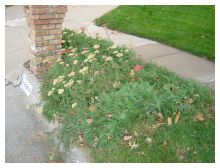
Homeowners have two options in developing a water-efficient garden and landscape:
- 1. Plan an entirely new landscape; or
- 2. Develop greater water efficiency in the existing landscape.
On large sites, both approaches may be possible as new sections are developed while older areas are remodeled. In planning new sites or adding new plants to existing sites, whenever possible you should choose plants for most of your landscape that can survive short periods of heat and drought. A good way to determine which plants can endure in the garden or landscape without extra water is to observe native plants.
The better and deeper the soil preparation and improvement, the greater will be the plant's ability to survive.
List of Ornamental Plants
Ornamental plants are often focal points in the landscape. You can find ornamental plants in a variety of cultivars, from roses to grasses and from deciduous to evergreen. Some ornamentals that bloom attract hummingbirds and butterflies, while others simply add color year round.
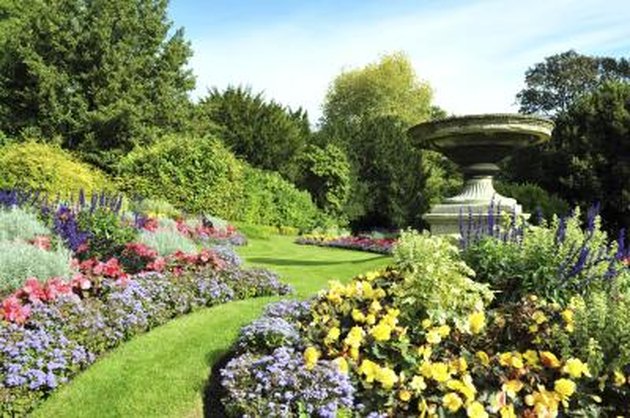
VIDEO OF THE DAY
Roses
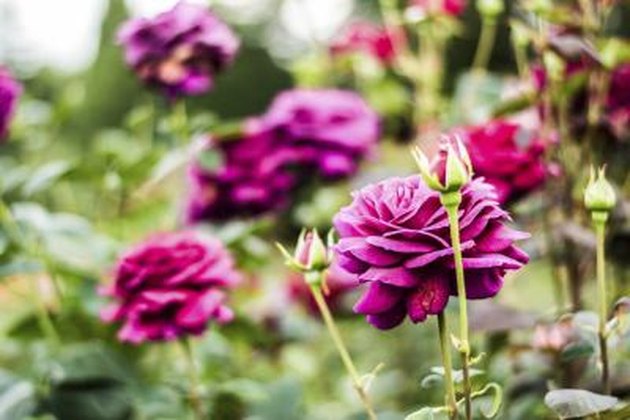
Roses have many different cultivars. You can plant rose bushes, tree roses, climbing roses, miniature roses and shrub roses in every color of the rainbow.
Ornamental Bulb Plants
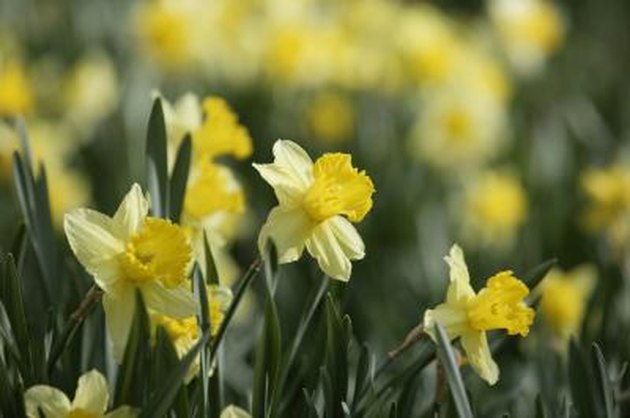
Lilies, tulips, daffodils and onion plants are among the ornamental varieties that grow from bulbs or rhizomes. Plants grown from bulbs bloom repeatedly, but you may need to dig up the bulbs and store them over winter in colder climates. You can replant the same bulbs in the spring for seasonal blooms.
Trees
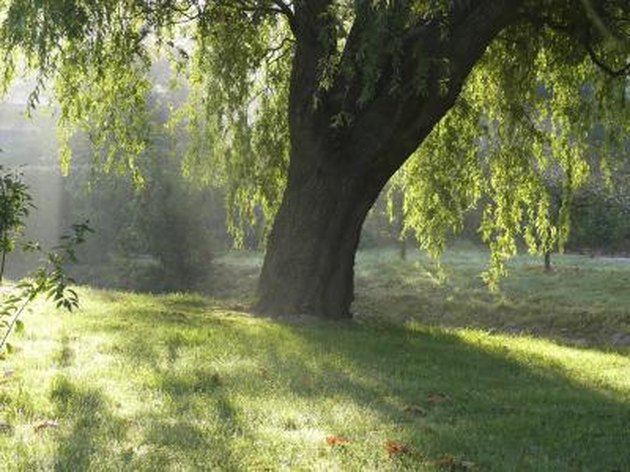
Japanese maple, along with many other varieties of maple, weeping willow and birch are among the varieties of ornamental trees that do not bloom. Ornamental trees that do bloom include magnolia, pear, cherry, apple and lilac. All of these ornamental trees are deciduous--they lose their leaves over the winter and sprout new growth in the spring.
Conifers
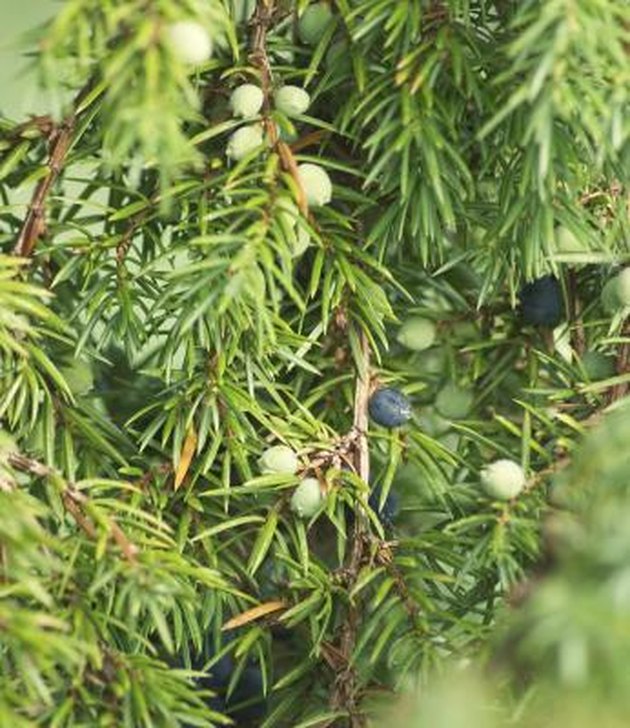
Conifers are evergreen trees and shrubs that remain green throughout every season. They are among the most-popular ornamental plants because they add color to the landscape even during the harshest winters. Fir, cedar and juniper have several varieties within the species, all of which are considered ornamental conifers.
Ornamental Shrubs
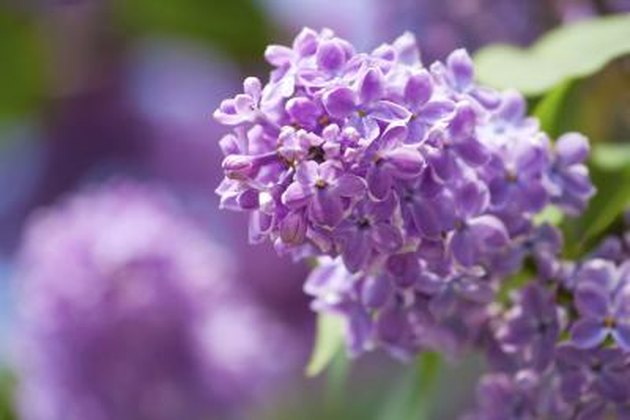
Weigela, barberry, camellia, lilac and heath are popular varieties of ornamental shrubs. Certain species of maple and dogwood also are considered shrubs. With the exception of low-growing conifers such as junipers, and others such as holly, most ornamental shrubs are deciduous.
Ornamental Grasses

Meadow foxtail, bamboo, reed grass, pampas grass, sedge, blue fescue, papyrus and fountain grass are among the ornamental grasses available to decorate your landscape. Many ornamental grasses are evergreen.
Herbs
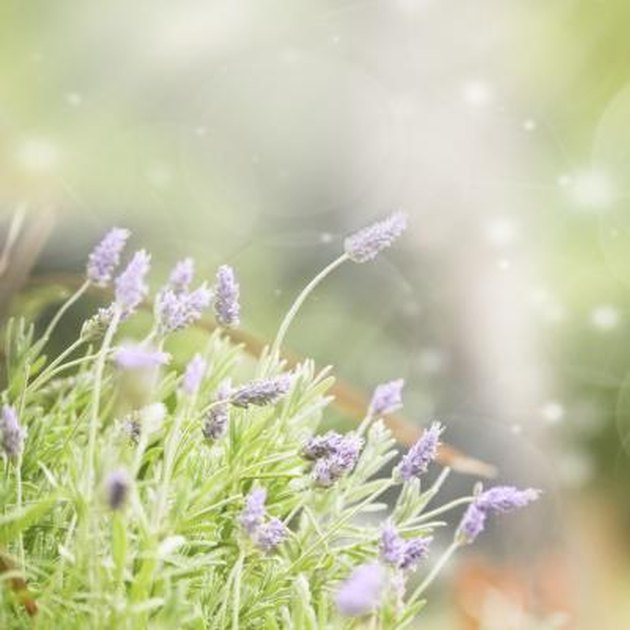
Aromatic herbs such as lavender, sage, mint and marigold are just a few of the ornamental plants that are propagated for culinary and aromatherapy uses. Thyme, basil and rosemary also are ornamental plants that add flavor to your recipes and provide a pleasing scent in your garden.
Ornamental plant
This article needs additional citations for verification. (December 2012) (Learn how and when to remove this template message)
|
Ornamental plants are plants that are grown for decorative purposes in gardens and landscape design projects, as houseplants, cut flowersand specimen display. The cultivation of ornamental plants is called floriculture, which forms a major branch of horticulture.
Contents
Garden plants[edit]
Commonly, ornamental [garden] plants are grown for the display of aesthetic features including: flowers, leaves, scent, overall foliage texture, fruit, stem and bark, and aesthetic form. In some cases, unusual features may be considered to be of interest, such as the prominent thorns of Rosa sericea and cacti. In all cases, their purpose is for the enjoyment of gardeners, visitors, and the public institutions.
Trees[edit]
Similarly certain trees may be called ornamental trees. This term is used when they are used as part of a garden, park, or landscape setting, for instance for their flowers, their texture, form, size and shape, and other aesthetic characteristics. In some countries trees in 'utilitarian' landscape use such as screening, and roadside plantings are called amenity trees.
Grasses[edit]
Ornamental grasses are grasses grown as ornamental plants. Many ornamental grasses are true grasses (Poaceae), however several other families of grass-like plants are typically marketed as ornamental grasses. These include the sedges (Cyperaceae), rushes (Juncaceae), restios (Restionaceae), and cat-tails (Typhaceae). All are monocotyledons, typically with narrow leaves and parallel veins. Most are herbaceous perennials, though many are evergreen and some develop woody tissues. Ornamental grasses are popular in many countries. They bring striking linear form, texture, color, motion, and sound to the garden, throughout the year.
Ornamental grasses are popular in many colder hardiness zones for their resilience to cold temperatures and aesthetic value throughout fall and winter seasons. [1]
Cultivation[edit]
For plants to be considered ornamental, they require specific work and pruning by a gardener. For instance, many plants cultivated for topiary and bonsai would only be considered to be ornamental by virtue of the regular pruning carried out on them by the gardener, and they may rapidly cease to be ornamental if the work was abandoned.
Ornamental plants and trees are distinguished from utilitarian and crop plants, such as those used for agriculture and vegetable crops, and for forestry or as fruit trees. This does not preclude any particular type of plant being grown both for ornamental qualities in the garden, and for utilitarian purposes in other settings. Thus lavender is typically grown as an ornamental plant in gardens, but may also be grown as a crop plant for the production of lavender oil.
The term[edit]
The term ornamental plant is used here in the same sense that it is generally used in the horticultural trades.[2][3] The term largely corresponds to 'garden plant', though the latter is much less precise, as any plant may be grown in a garden. Ornamental plants are plants which are grown for display purposes, rather than functional ones. While some plants are both ornamental and functional, people usually use the term “ornamental plants” to refer to plants which have no value beyond being attractive, although many people feel that this is value enough. Ornamental plants are the keystone of ornamental gardening, and they come in a range of shapes, sizes and colors suitable to a broad array of climates, landscapes, and gardening needs.
Some ornamental plants are grown for showy foliage. Their foliage may be deciduous, turning bright orange, red, and yellow before dropping off in the fall, or evergreen, in which case it stays green year-round. Some ornamental foliage has a striking appearance created by lacy leaves or long needles, while other ornamental are grown for distinctively colored leaves, such as silvery-gray ground covers and bright red grasses, among many others.
Other ornamental plants are cultivated for their blooms. Flowering ornamental are a key aspect of many gardens, with many flower gardeners preferring to plant a variety of flowers so that the garden is continuously in flower through the spring and summer. Depending on the types of plants being grown, the flowers may be subtle and delicate, or large and showy, with some ornamental plants producing distinctive aromas which paint a palette of scents in addition to colors.
Garden: Landscape and Ornamental Gardening
In landscape gardening an overall aesthetic effect is sought, usually to enhance dwellings, public buildings, and monuments and to integrate and beautify parks, playgrounds, and fairgrounds. Formal landscaping involves artificial modifications of the terrain and emphasizes balanced plantings and geometrical design; the naturalistic style incorporates plantings with the natural scenery.
Ornamental gardening and landscape gardening are ancient arts. The Egyptians built formal walled gardens, and the Mesopotamians constructed private parks and terraced gardens—usually on artificial mounds or supported by columns, as the Hanging Gardens of Babylon. The Persians were especially skilled in using water for decorative effects; the Moors carried Middle Eastern styles to Spain. In the East the planting of sacred groves was spread by the Buddhists from India to China and set a style there for naturalistic gardens, in which the beauty of the natural scenery was accentuated by distributing plants so as to allow them free growth and set off their colors and fragrances to best advantage. The Japanese adopted this principle and elaborated it into a distinct style of highly disciplined arrangements of plants and their settings with the object of achieving subtle beauty based on economy and simplicity. The Japanese art of bonsai gave rise to the unique miniature gardens and dish gardens.
In Europe landscape gardening was highly developed under the Roman Empire; formal gardens, often terraced and adorned with statuary and fountains, were designed by architects. The Crusaders brought back from the East new gardening techniques that gave great impetus to horticulture in Western Europe. During the Renaissance the classical style was revived in Italy; the Italian gardens, planned by leading artists, sometimes went to extremes of formality and decor, among them those employing elaborate waterworks displays (see fountain ). The Italian style was widely imitated. In Spain the Italian influence was modified by Moorish features. In turn, the Spaniards and the Portuguese introduced their ideas in the Americas, where these techniques were combined with the already well-developed Aztec and Inca traditions. The Dutch, famous for the development of the nursery , were noted also for their topiary work , an art practiced earlier by the Romans. France became the leader in formal landscaping; the work of André Le Nôtre is exemplified in the gardens of Versailles. In the 18th cent. England inaugurated a revival of the naturalistic trend under such leaders as William Kent , Capability Brown , and Humphrey Repton.
The 19th cent. brought a partial reversion to formal landscaping and an interest in horticulture as well as in design. American landscape artists generally followed the example of the English masters. Landscaping, especially of public parks and buildings, was stimulated by the work of A. J. Downing , Calvert Vaux , and F. L. Olmsted and his son. Today landscape gardening stresses practical as well as aesthetic design, selecting from a wealth of gardening traditions and emphasizing casual, naturalistic effects.
The garden around the house is typically divided into useful and decorative or ornamental garden. Useful garden is intended for production of vegetables and fruits, while the ornamental garden is dedicated to the enjoyment in the beauty of plants, greenery and to show skills of amateur gardener. Since vegetables and fruit plants are full of beauty of nature, some very skilful gardeners combine vegetables with ornamental plants to blur border between useful and ornamental garden.
Ornamental garden is the pride of every house. It reflects the owner and gardener. In the ornamental garden is shown ability and imagination of the gardener. Different combinations of plants in different garden styles can express the beauty of nature that surrounds us. The main role in the garden have plants or various design elements. Owner's or gardener's choice is, what will have the main role.
Ornamental garden can be formed in accordance with any of garden styles. In doing so, it makes sense to keep to the rules of each garden style so the garden will not become a kind of semi-finished work. If you have enough imagination and do not want to be subordinated to the rules of the individual garden styles, you can design garden completely free. Your imagination should be free, while including a variety of garden elements which should be combined harmoniously. For ornamental garden is harmony very important.
Ornamental garden should have a touch of the family garden. If you do not want to have family garden, then at least part of the garden should be for the family so that we can use it to socialize and enjoy it without causing any major damage. Often owners of the garden put in it their souls and love. They carefully nurture plants so that the garden is constantly looking as good as possible. Visiting friends or relatives, especially if they have children, can leave negative impact in it. Therefore, it is appropriate that at least a part of the garden is intended for visitors and other parts are not accessible to them.
Ornamental gardens are visually similar to parks. Parks are usually very nicely decorated and each plant and each element has a precise location. Such gardens can be very beautiful and reflect the effort gardener, but they often lack familiarity. The garden that is not perfect is more friendly and familiar. Too perfect gardens are too sterile to be enjoyable. Walking through them is like visiting shops with porcelain dolls. You must be constantly careful to avoid damaging anything.

